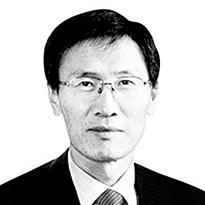[Column] Tipping the scale between shrimp and whale

The author, a former foreign minister, is an emeritus professor at Seoul National University.
“If a shrimp is not to be crushed in a battle between whales, what should it do?” asks a character in a popular TV drama on a chaebol family in Korea. After wrestling with the question, the protagonist reaches the conclusion that a shrimp must get bigger.
Personally, I don’t like the metaphor as it reflects a sense of defeatism and resignation. People often forget what to do on their own after blaming the powerful. But Koreans proved their real potential to achieve a rags-to-riches miracle. They turned their shrimp-sized economy into a dolphin-sized economy, if you will.
The Korean government played a key role in developing memory chips. Based on a $29 million loan from the World Bank in 1979, the government set up a semiconductor production facility inside the Korea Electronics Technology Institute (KETI) to foster the chip industry. Seven years later, the government launched a joint project to develop ultra-large-scale integration (ULSI) chips with the private sector and academia. Thanks to the move, Korea became a global frontrunner in semiconductors.
As chips are essential parts of nearly everything, they constitute a strategic industry. If an external force controls a particular component or engineering process, it can wield leverage on others. China or the U.S. cannot deal with Taiwan’s TSMC lightly due to the massive impact the foundry giant will have on them in case it stops production.
The Netherlands, a global powerhouse in the materials and component sector, is no exception. The materials industry makes up 27 percent of the country’s GDP and the rest of the world relies on the Dutch for 90 percent of its demand for silicon wafers. Kwon Seok-joon, a professor of chemical engineering at Sungkyunkwan University, attributes the unrivalled competitiveness of the chip industry in the Netherlands to its government’s unflinching support for chip companies to help them acquire core technologies for next generation engineering processes. Prof. Kwon stresses that Korea must learn from the Dutch government, which helped create a platform on which an industry can form a cluster to maximize the merits of joint research among companies, universities and research institutes.
Fortunately, the Yoon Suk-yeol administration plans to set up a committee to draw up national strategies for the hi-tech industry under the office of the prime minister. But it is uncertain whether the committee can successfully create an efficient linking system for related sectors. Also unclear is how it will draw up a big picture for our semiconductor strategy and if it could really streamline inefficient government support systems.
On Dec. 15, the Trade, Industry, Energy, SMEs and Start-ups Committee in the legislature passed a revision to the act on promoting national strategic industry. The revision aims to designate — and establish — a specialized complex, expand the scope of exempting companies from preliminary feasibility studies, shorten the time needed for permission and increase the quota for students studying high tech subjects at college. The government took the right direction. But if a university has to cut quotas for other departments in order to draw more students to the semiconductor department, as required by the current law, that will not be effective. Would professors really yield to the pressure to cut the number of students?
Another problem is a delayed discussion on tax credits for the chip industry from sharp disagreements between the governing People Power Party (PPP) and the Democratic Party (DP). A revision to the Act on Restricting Special Tax Credit is urgently needed given the fast cycle of technology change. First of all, the Ministry of Economy and Finance opposes a raising of tax credit for chipmakers by more than 8 percent for fear of a reduction in tax revenue. But if our chipmakers can win a global race against competitors and make more money, tax revenue will increase sharply, not decrease. The government must take a far-sighted approach.
The DP also opposes a 20 percent tax credit for large companies, a 25 percent tax credit for middle market enterprises, and a 30 percent credit for small and mid-size companies. Instead, the liberal party insists on a 10 percent, 15 percent and 30 percent credit for the respective categories. But in the U.S., a revision was proposed to give a 25 percent tax credit to foreign companies building chip factories in America, and in Taiwan, a revision was already submitted to lift a tax credit for chipmakers to 25 percent from current 15 percent.
The DP upholding fairness can be understood. But it would be better if the party presents a bolder alternative to achieve fairness and strategic efficiency at the same time. Due to technological vulnerability, Korea’s tech self-sufficiency on chip materials, parts and equipment stands at a mere 30 percent while still relying on Japan for much. Could our political circles, including the government, hammer out a fundamental solution to help companies, small and large, to catch up with Japan while nodding to a drastic tax cut for big companies? The DP, holding 169 seats in the 300-member legislature, can give a fresh shock to the country.
America’s GDP is 13 times larger than Korea’s, and China’s GDP nine times Korea’s. Those countries, including Japan and Taiwan, are investing in chips in a more agile, concerted and aggressive way. If our politicians continue dragging their feet, the country may revert to being a shrimp again.
Translation by the Korea JoongAng Daily staff.










with the Korea JoongAng Daily
To write comments, please log in to one of the accounts.
Standards Board Policy (0/250자)